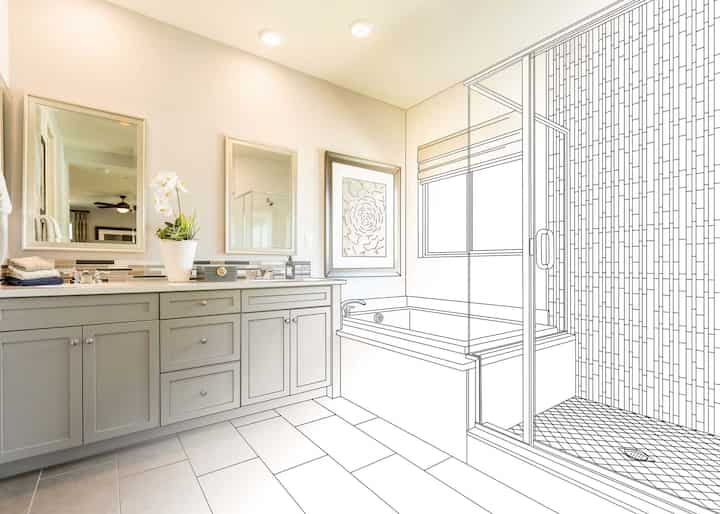
Selecting the right tile for your bathroom remodel
When it comes to remodeling a bathroom, selecting the right tiles for the space can be a daunting task. With so many options available on the market, it can be challenging to know where to start. However, choosing the right tile is essential to ensure that your bathroom not only looks great but also functions well for years to come.
Understanding your bathroom's needs
An essential aspect of selecting the appropriate tile for a bathroom remodel is to understand the functional requirements of the space. This includes considering the size, layout, and usage patterns of the bathroom.
For example, a small bathroom may require lighter colored tiles to create the illusion of more space, while a larger bathroom can accommodate darker colored tiles. Additionally, the layout of the bathroom can influence the type of tile selected. A bathroom with a lot of corners and angles may benefit from smaller tiles that can be cut to fit the space, while a bathroom with a more straightforward layout can accommodate larger tiles.
Understanding the usage patterns of the bathroom is also crucial when selecting the right tile. For instance, if the bathroom is frequently used by children or elderly individuals, it may be necessary to choose tiles that are slip-resistant and durable to avoid potential accidents. Additionally, if the bathroom is used mainly for bathing or showering, it is essential to select tiles that are water-resistant and easy to clean.
Types of bathroom tiles to consider
Various types of tiles are available for use in bathrooms, each with unique characteristics and benefits to consider during a remodel. One popular type is ceramic tile, which is known for its durability and versatility. It can be glazed or unglazed, and comes in a wide range of colors and patterns. Ceramic tile is also relatively easy to clean, making it a great choice for bathrooms that see a lot of use. However, it can be slippery when wet, so it may not be the best option for floors in bathrooms used by older adults or children.
Another type of tile to consider is porcelain tile, which is similar to ceramic but is denser and more water-resistant. This makes it a good choice for floors and walls in bathrooms that are prone to moisture. Porcelain tile is also available in a variety of colors and patterns, and can even be made to look like natural stone. However, it can be more expensive than ceramic tile, so it may not be the best choice for those on a tight budget.
Choosing the right size and shape
The size and shape of tiles play a crucial role in determining the overall look and feel of a bathroom. When selecting tiles for a bathroom remodel, it is essential to consider the size of the space and the desired effect.
If the bathroom is small, it is recommended to use smaller tiles to make the room feel more spacious. Conversely, larger tiles can be used in larger spaces to create a more expansive feel. Rectangular tiles can make a space feel longer and more narrow, while square tiles can create a more symmetrical and balanced look. It is also important to consider the shape of the room and the placement of fixtures, such as the toilet and sink, when selecting the size and shape of tiles.
In addition to size and shape, the texture of tiles can also impact the overall look of a bathroom. Smooth tiles can create a modern and sleek appearance, while textured tiles can add depth and dimension to a space. Mosaic tiles, which are made up of small individual pieces, can be used to create intricate and unique designs.
Selecting the best material for your bathroom
Different materials can be considered when choosing the best option for bathroom tiles. Porcelain is a popular choice due to its durability, low maintenance, and water-resistant properties. It is available in a variety of colors, patterns, and textures, making it a versatile option for any bathroom design. Porcelain tiles are also easy to clean and are less likely to absorb water, making them ideal for humid bathrooms.
Another popular option is ceramic tiles, which are known for their affordability and versatility. They come in a variety of colors, sizes, and shapes, making them easy to match with any bathroom decor. Ceramic tiles are also easy to maintain and can withstand high levels of foot traffic. However, they are less durable than porcelain tiles, and may crack or chip over time.
Tips for making your decision
Consider these helpful tips when deciding on the best material for your bathroom tiles.
First, consider the functionality and durability of the tile. Bathrooms are high traffic areas, and the tiles must withstand frequent exposure to water, moisture, and cleaning products. Porcelain and ceramic tiles are excellent choices for their durability, resistance to water, and ease of maintenance. Natural stone tiles, such as marble, granite, and slate, are also popular choices for their beauty and durability. However, they require more maintenance and sealing to prevent water damage.
Second, consider the style and design of the tile. The tile you choose will impact the overall look and feel of your bathroom. It is essential to choose a tile that complements your personal style and the existing decor. If you prefer a modern and sleek look, consider large format tiles or geometric patterns. If you prefer a more traditional look, consider mosaic tiles or subway tiles. Additionally, consider the color of the tile and how it will interact with the lighting in your bathroom. A light-colored tile will reflect more light and make the space feel brighter, while a dark-colored tile will absorb more light and create a more intimate ambiance. If you’re looking for bathroom tile services to complement your home, get in touch with our experienced professionals. Don’t wait – give our team a call today!